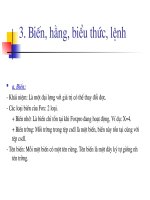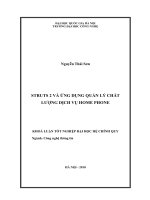Chapter 2 tầng ứng dụng
Bạn đang xem bản rút gọn của tài liệu. Xem và tải ngay bản đầy đủ của tài liệu tại đây (4.35 MB, 110 trang )
Computer Networking: A Top Down
Approach
Seventh Edition
Chapter 2
Application Layer
Slides in this presentation contain hyperlinks.
JAWS users should be able to get a list of links
by using INSERT+F7
Copyright © 2017, 2013, 2010 Pearson Education, Inc. All Rights Reserved
Learning Objectives (1 of 7)
2.1 Principles of network applications
2.2 Web and HTTP
2.3 electronic mail
− SMTP, POP3, IMAP
2.4 DNS
2.5 P2P applications
2.6 video streaming and content distribution networks
2.7 socket programming with UDP and TCP
Copyright © 2017, 2013, 2010 Pearson Education, Inc. All Rights Reserved
Application Layer
our goals:
• learn about protocols by
examining popular
application-level protocols
– HTT P
– FT P
– SMTP / POP3 / IMAP
– DNS
• conceptual,
implementation
aspectsa of network
application protocols
– transport-layer
service models
– client-server
• creating network
paradigm
applications
– peer-to-peer
– socket API
paradigm
– content distribution
Copyright © 2017, 2013, 2010 Pearson Education, Inc. All Rights Reserved
Some Network Apps
• voice over IP (e.g., Skype)
• web
• real-time video
conferencing
• text messaging
• remote login
• P2P file sharing
• multi-user network
games
• social networking
• search
• …
• …
• streaming stored video
(YouTube, Hulu, Netflix)
Copyright © 2017, 2013, 2010 Pearson Education, Inc. All Rights Reserved
Creating a Network App
write programs that:
• run on (different) end systems
• communicate over network
• e.g., web server software
communicates with browser
software
no need to write software for
network-core devices
• network-core devices do not run
user applications
• applications on end systems allows
for rapid app development,
propagation
Copyright © 2017, 2013, 2010 Pearson Education, Inc. All Rights Reserved
Application Architectures
Possible structure of applications:
ã client-server
ã peer-to-peer (P2P)
Copyright â 2017, 2013, 2010 Pearson Education, Inc. All Rights Reserved
Client-Server Architecture
server:
• always-on host
• permanent IP address
• data centers for scaling
clients:
• communicate with server
• may be intermittently
connected
• may have dynamic I P
addresses
ã do not communicate directly
with each other Copyright â 2017, 2013, 2010 Pearson Education, Inc. All Rights Reserved
P2P Architecture
• no always-on server
• arbitrary end systems directly
communicate
• peers request service from other
peers, provide service in return to
other peers
– self scalability – new peers
bring new service capacity, as
well as new service demands
• peers are intermittently
connected and change IP
addresses
– complex management
Copyright © 2017, 2013, 2010 Pearson Education, Inc. All Rights Reserved
Processes Communicating
process: program
running within a host
• within same host,
two processes
communicate
using interprocess
communication
(defined by OS)
clients, servers
client process: process that
initiates communication
server process: process that
waits to be contacted
• aside: applications with P2P
architectures have client
processes & server
processes
ã processes in
different hosts
communicate by
exchanging Copyright â 2017, 2013, 2010 Pearson Education, Inc. All Rights Reserved
Sockets
• process sends/receives messages to/from its socket
• socket analogous to door
– sending process shoves message out door
– sending process relies on transport infrastructure on
other side of door to deliver message to socket at
receiving process
Copyright © 2017, 2013, 2010 Pearson Education, Inc. All Rights Reserved
Addressing Processes
• to receive messages, process must
have identifier
• host device has unique 32-bit IP
address
• Q: does IP address of host on which
process runs suffice for identifying
the process?
− A: no, many processes can be
running on same host
• identifier includes both IP
address and port numbers
associated with process on host.
• example port numbers:
– HTTP server: 80
– mail server: 25
• to send HTTP message to
gaia.cs.umass.edu web server:
– IP address: 128.119.245.12
– port number: 80
• more shortly…
Copyright © 2017, 2013, 2010 Pearson Education, Inc. All Rights Reserved
App-layer protocol defines
• types of messages
exchanged,
– e.g., request, response
• message syntax:
– what fields in messages
& how fields are
delineated
• message semantics
– meaning of information in
fields
open protocols:
• defined in RFCs
• allows for
interoperability
• e.g., HTTP, SMTP
proprietary protocols:
• e.g., Skype
• rules for when and how
processes send & respond to
messages
Copyright © 2017, 2013, 2010 Pearson Education, Inc. All Rights Reserved
What Transport Service Does An App
Need?
data integrity
throughput
• some apps (e.g., file
transfer, web transactions)
require 100% reliable data
transfer
• some apps (e.g., multimedia)
require minimum amount of
throughput to be “effective”
• other apps (e.g., audio) can
tolerate some loss
• other apps (“elastic apps”) make
use of whatever throughput they
get
timing
security
• some apps (e.g., Internet
telephony, interactive
games) require low delay to
be effective
ã encryption, data integrity,
Copyright â 2017, 2013, 2010 Pearson Education, Inc. All Rights Reserved
Transport Service Requirements: Common
Apps
Application
Data Loss
Throughput
Time-Sensitive
file transfer
no loss
elastic
no
no loss
elastic
no
Web documents
no loss
elastic
no
real-time audio/video
loss-tolerant
audio: 5kbps-1Mbps
video:10kbps-5Mbps
yes, 100’s msec
stored audio/video
loss-tolerant
same as above
yes, few secs
interactive games
loss-tolerant
few kbps up
yes, 100’s msec
text messaging
no loss
elastic
yes and no
Copyright © 2017, 2013, 2010 Pearson Education, Inc. All Rights Reserved
Internet Transport Protocols Services
TCP service:
• reliable transport
between sending and
receiving process
• connection-oriented: setup
required between client and
server processes
UDP service:
• flow control: sender
won’t overwhelm receiver
• unreliable data transfer between
sending and receiving process
• congestion control:
throttle sender when
network overloaded
• does not provide: reliability, flow
control, congestion control, timing,
throughput guarantee, security, or
connection setup,
• does not provide:
timing, minimum
throughput guarantee,
security
Q: why bother? Why is there a UDP?
Copyright © 2017, 2013, 2010 Pearson Education, Inc. All Rights Reserved
Internet Apps: Application, Transport
Protocols
Application
Application layer
protocol
Underlying transport
protocol
SMTP [RFC 2821]
TCP
remote terminal access
Telnet [RFC 854]
TCP
Web
HTTP [RFC 2616]
TCP
file transfer
FTP [RFC 959]
TCP
streaming multimedia
HTTP (e.g., YouTube),
RTP [RFC 1889]
TCP or UDP
Internet telephony
SIP, RTP, proprietary
(e.g., Skype)
TCP or UDP
Copyright © 2017, 2013, 2010 Pearson Education, Inc. All Rights Reserved
Securing TCP
TCP & U DP
SSL is at app layer
• no encryption
• apps use SSL libraries, that “talk”
to TCP
• cleartext passwds sent into
socket traverse Internet in
cleartext
SSL socket A P I
SS L
• cleartext passwords sent into
socket traverse Internet encrypted
• provides encrypted TCP
connection
• see Chapter 8
ã data integrity
ã end-point authentication
Copyright â 2017, 2013, 2010 Pearson Education, Inc. All Rights Reserved
Learning Objectives (2 of 7)
2.1 Principles of network applications
2.2 Web and HTTP
2.3 electronic mail
− SMTP, POP3, IMAP
2.4 DNS
2.5 P2P applications
2.6 video streaming and content distribution networks
2.7 socket programming with UDP and TCP
Copyright © 2017, 2013, 2010 Pearson Education, Inc. All Rights Reserved
Web and HTTP
First, a review…
• web page consists of objects
• object can be HTML file, JPEG image, Java applet,
audio file,…
• web page consists of base HTML-file which
includes several referenced objects
• each object is addressable by a URL, e.g.,
Copyright © 2017, 2013, 2010 Pearson Education, Inc. All Rights Reserved
HTTP Overview (1 of 2)
HTTP: hypertext transfer
protocol
• Web’s application layer
protocol
• client/server model
– client: browser that
requests, receives, (using
HTTP protocol) and
“displays” Web objects
– server: Web server sends
(using HTTP protocol)
objects in response to
requests
Copyright © 2017, 2013, 2010 Pearson Education, Inc. All Rights Reserved









